|
Life at The Croft
MEMORIES OF GROWING
UP IN
POST-WAR BOURNE
|
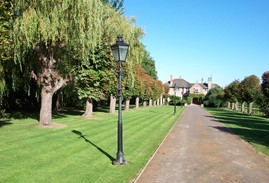 |
by Julia Farwell
I had a very special place in the life of my
grandfather. I was the first grandchild, born on his birthday in 1940 and,
as it later turned out, I was the only girl. We had a very special bond.
Many years we celebrated our birthdays together, sometimes in very special
places.
I loved coming to The Croft to stay with my grandparents because their
house seemed so big, the garden so huge and there were lots of things to
do and places to hide in. Later, when my brother was old enough, we used
to ride our bikes or go into the office and annoy “Mr Andrews” who was our
grandfather’s accountant. We also had lots of fun getting in the way of
the kitchen maids who always had time for us. It was in there that we
watched cook making butter, cream, sausages, pies and cakes for tea. The
kitchen was always lovely and warm and welcoming, even though we were not
really allowed in there. The smells emanating from it were enough to make
anyone hungry, and so break the rules. I realise now that my grandparents
lived a very privileged life style.
As for the house itself, it was lovely. You entered the front door into a
beautiful large wooden panelled hallway filled with lots of big shiny
brass jugs, planters, horse brasses, lamps and such like, with a
grandfather clock which ticked away the hours, chiming hourly. My
grandfather used to wind this up every Sunday morning when he came
downstairs and would check the time against his pocket watch which he wore
on a chain hung across his vast expanse of tummy. Opposite the front door
was the dining room where we all enjoyed our family meals. One thing I
shall always remember is seeing my grandfather sharpening the carving
knife on a stone and then carving the joints at a separate carving table
while the assembled throng awaited their lunch. Many a happy meal was
spent in this room.
To the right of the dining room there was a nice sitting room with views
over the rose garden, rockery, and the fields beyond which often had cows
called Lincolnshire Reds in them (his pride and joy) and from the other
window could be seen the tennis court and the gardens beyond. Between
these two rooms were French doors leading out to a veranda where we could
sit in the shade on a hot summer’s day. I can remember doing this often,
drinking orange juice or having tea and cakes brought out to us. To the
left side of the hallway were the stairs then a room which we all called
the smoke room. This was where the grown-ups went to smoke and a foul
smelling room it was too.
Beyond that room were the kitchens, comprising a
butler’s pantry, the main kitchen, the scullery, and a huge walk in
larder. I can remember seeing several large enamel jugs standing on a slab
all filled with lovely Jersey milk which used to come up from the farm
every day ready for breakfast. When it had rested, a thick head of cream
came to the top. This was then skimmed off and either made into butter,
cream cheese, or used as double cream on our cereal or fruit. Mmmm!
I remember as you went upstairs, on the half landing was another
grandfather clock and at the top my grandparents had a couple of rooms to
themselves on the right, one was their bedroom and then my grandfather had
a large dressing room with a basin in. My parents had a large double room
opposite the staircase then going to the left along the corridor there was
my room looking out over the front and down the drive, then the nursery
and next to that our nanny’s room or a maids room and a beautiful mosaic
bathroom and lavatory. I remember we always had lighted fires in our
bedrooms in the winter which made a lovely glow by which to go to sleep. I
can also remember maids coming up regularly to make up the fires, carrying
buckets of coal. On reflection today, it seems a bit like a scene from the
TV series Downton Abbey.
I loved to go with my grandfather to the farm at Dyke some days. I was
allowed to see “Mr Charlie” milk the cows and sometimes I tried myself but
was never very good at getting any milk. “Mr Charlie” used to have masses
of chickens too, all running around the farmyard. Then we’d go and see the
piggery where often there were little piglets. Nelson and Captain, the two
cart horses, were also stabled in this farmyard and I loved to stroke them
and watch them at work in the fields. Those were the days before my
grandfather had tractors.
This was a time of austerity after the Second World War and it was a great
place to be down on the farm as there did not seem to be any shortages of
food to us. As we grew up, we enjoyed helping in the fields at harvest
time or walking with our grandparents from the house in Bourne across the
fields to Dyke then back down Mill Lane and home. A long walk for a small
child but we did not seem to mind as it was always made so interesting and
there were always different things to see along the way.
As the garden at The Croft was so big, we played hide and
seek around the place or watched the lovely cows which were in the field
at the bottom of the garden or in the field along the side of the drive.
We also used to go mushrooming in these fields too, picking huge field
mushrooms which we would have for breakfast the next day. They were so
full of flavour, not like the kind you buy today.
The drive at the front of The Croft was another source of
amusement too, either collecting conkers from the many beautiful chestnut
trees which lined both sides or we would hide behind the big black wooden
gates at the entrance and watch people who passed, sometimes jumping out
to surprise them and even making them jump. Not everyone was amused
though. Everyone seemed to look in when they walked past the driveway
because it was a wonderful sight looking up to the house at the top end,
beyond the large trees, a place which we so proudly called home. It was
our home!
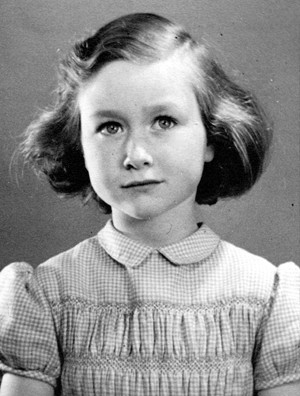 |
Julia Heath, aged 3 (left), a frequent visitor to The Croft,
and again in the rock garden (right), aged 10.
|
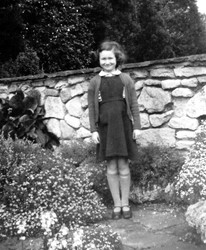 |
|
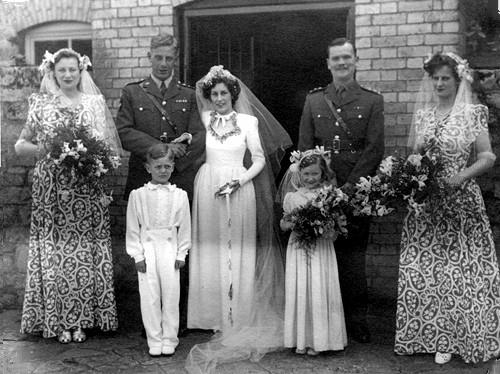 |
|
Julia was also a bridesmaid at the wedding in
1946 of Joy Cooke to Guards' officer Captain Robert Feltham at the Abbey
Church, Bourne. Joy's brother, Andrew, was later to become owner of The Croft which
he bought in 1960. |
|
Our grandparents were a very loving couple, giving us all the love that
grandparents are supposed to do. I remember grandfather being a very large
gentleman and grandmother rather small. It amused me seeing them together.
They played games with us and encouraged us to learn the names of all the
wild flowers, trees and birds that visited the garden, pointing out the
names of them all in turn. We learned the names of the flowers in the
garden, the fruit trees, and vegetables they grew.
They took us to church and encouraged us to go to Sunday school. I
actually went to nursery school across the road, to Miss Tyler’s for a
while. When I was ten, I remember for my birthday present my grandfather
bought me my first grown-up bicycle but I was mad because my brother got
one too. He had chosen a matching pair for us of blue and white and we
loved them. We were encouraged to ride all over the place, to go
exploring, which we did and fun it was too. Those were the days when you
could allow your children to go off on their own.
My grandfather used to go to the farm most days. I remember seeing him
drive off every morning in his car accompanied by his faithful friend,
Susan, his cocker spaniel. He also used to go off to the Corn Exchange
sometimes or he would go to Boston, or up to London. No doubt all this was
to do with his dealings in the corn trade but I was too young to
understand exactly what he did. It was years later that I discovered where
he went to in London as my office was over the road from the Corn
Exchange, a most strange coincidence.
He was a very proud man, much loved and respected and a firm
disciplinarian. He took great pride in his farm and dearly wished that my
father would leave the Royal Air Force and take over the business but that
was not to be. My father’s first love was the RAF and not farming although
he was very interested in it.
One of my other lasting memories of this lovely couple was the Sunday
afternoon ritual in the summer months which was to go out for a drive.
This meant driving around the local country side, inspecting, hedges,
ditches, fields, stock etc. He always wanted to make sure that his was the
best looking, and best kept farm and was therefore very critical.
Another thing I remember about The Croft was the summer tennis parties on
the grass court. I learned to play tennis here too, albeit not to the
standard that my parents would have liked, but it was fun, and something
that as we grew older, my brother and I could also play in the holidays.
My grandfather was very particular about his tennis court and we were paid
one penny for every plantain weed we could find and then dig up with a
special tool. It was not an easy task and we did not get rich.
Another fond memory is how my grandfather loved his food. We always had
butter balls on the table and he used to put several onto his plate every
meal, not for his bread as most people would do but into his potatoes and
vegetables. He also had a great love of cream and that would lavishly coat
every pudding course. There was always a whole Stilton at Christmas time,
suitably fed with port which was also one of his favourite things.
We ate four meals a day in those days, breakfast (nearly always cooked as
well as cereal), lunch was the main meal of the day and was three courses
and that was followed by tea with sandwiches, cakes and biscuits then a
light snack in the evening. We children had gone to bed then, so I don’t
know what the grown-ups ate but we had porridge, or bread and milk or
something in our bedrooms before we got into bed.
The house was a happy one, a home filled with warmth, love, and loads of
atmosphere. In the earlier days of my childhood they employed several
house staff who I got on well with, plus a gardener, and “the man in the
office”. It broke my heart when I heard many years later that the house
was going to be pulled down and have masses of new houses built on the
land. I know this trend had started years ago when the surrounding fields
were sold off for building but I always hoped that the house itself would
find someone to love and cherish it. However I guess it was too big for
people today and certainly the garden was, beautiful though it may have
been. It is all now just a very happy memory of my wonderful privileged
childhood, and of days gone by.
WRITTEN MAY 2012
|
BIOGRAPHICAL NOTE
Julia Farwell is the daughter of the late Sir Maurice
Heath and his wife, Mary, who
was daughter of Richard Boaler Gibson, owner of The Croft in North Road,
Bourne. She now lives at Chichester in West Sussex.
|
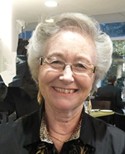 |
Return to Richard Gibson

Go to:
Main Index Villages
Index
|



